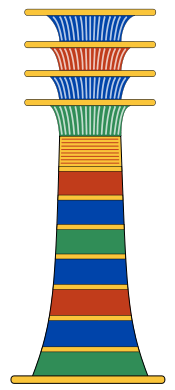
Djed
Encyclopedia

Osiris
Osiris is an Egyptian god, usually identified as the god of the afterlife, the underworld and the dead. He is classically depicted as a green-skinned man with a pharaoh's beard, partially mummy-wrapped at the legs, wearing a distinctive crown with two large ostrich feathers at either side, and...
, especially in the form Banebdjedet
Banebdjedet
Banebdjedet was an Ancient Egyptian ram god with a cult centre at Mendes. Khnum was the equivalent god in Upper Egypt. His wife was the goddess Hatmehyt who was perhaps the original deity of Mendes. Their offspring was "Horus the Child" and they formed the so called "Mendesian Triad"...
(the ba
Egyptian soul
The ancient Egyptians believed that a human soul was made up of five parts: the Ren, the Ba, the Ka, the Sheut, and the Ib. In addition to these components of the soul there was the human body...
of the lord of the Djedet
Mendes
Mendes , the Greek name of the Ancient Egyptian city of Djedet, also known in Ancient Egypt as Per-Banebdjedet and Anpet, is known today as Tell El-Ruba ....
). Djedu is the Egyptian name for Busiris
Busiris
Busiris or Bousiris may mean several different things, including:-Places:*Busiris , a large ancient city of Egypt, capital of its nome*Busiris , an ancient city of Egypt, near the Egyptian Pyramids...
, a centre of the cult of Osiris. During the Renewal Festival
Sed festival
The Sed festival was an ancient Egyptian ceremony that celebrated the continued rule of a pharaoh...
, the djed would be ceremonially raised as a phallic symbol symbolising the "potency and duration of the pharaoh's rule". It has been compared to the Sumer
Sumer
Sumer was a civilization and historical region in southern Mesopotamia, modern Iraq during the Chalcolithic and Early Bronze Age....
ian concept of temen. The hieroglyph for djed may have given rise to the letter Samekh
Samekh
Samekh or Simketh is the fifteenth letter in many Semitic alphabets, including Phoenician, Hebrew, and Aramaic, representing . The Arabic alphabet, however, uses a letter based on Phoenician šin to represent ; however, that glyph takes Samekh's place in the traditional Abjadi order of the Arabic...
.
Ptah
Ptah
In Ancient Egyptian Religion, Ptah was the deification of the primordial mound in the Ennead cosmogony, which was more literally referred to as Ta-tenen , meaning risen land, or as Tanen, meaning submerged land, though Tatenen was a god in his...
, and Tatenen
Tatenen
Tatenen was the god of the primordial mound in Egyptian Mythology. His name means risen land or exalted earth, as well as referring to the silt of the Nile. As a primeval chthonic deity, Tatenen was identified with creation...
, are also sometimes referred to as "the noble Djed".
Gordon-Schwabe theory
In their 2004 book The Quick and the Dead, Andrew H. Gordon and Calvin W. Schwabe speculated that the ankhAnkh
The ankh , also known as key of life, the key of the Nile or crux ansata, was the ancient Egyptian hieroglyphic character that read "eternal life", a triliteral sign for the consonants ʻ-n-ḫ...
, djed, and was
Was
The was sceptre is a symbol that appeared often in relics, art and hieroglyphics associated with the ancient Egyptian religion...
symbols have a biological basis derived from ancient cattle culture, thus:
- the ankh, a symbol of life, the thoracic vertebrae of a bull (seen in cross sectionCross section (geometry)In geometry, a cross-section is the intersection of a figure in 2-dimensional space with a line, or of a body in 3-dimensional space with a plane, etc...
) - the djed, a symbol of stability, the base or sacrumSacrumIn vertebrate anatomy the sacrum is a large, triangular bone at the base of the spine and at the upper and back part of the pelvic cavity, where it is inserted like a wedge between the two hip bones. Its upper part connects with the last lumbar vertebra, and bottom part with the coccyx...
of a bull's spine - the was, a symbol of power and dominion, a staff made from a dried bull's penis
Gordon and Schwabe's speculation is based on the Egyptian belief that semen
Semen
Semen is an organic fluid, also known as seminal fluid, that may contain spermatozoa. It is secreted by the gonads and other sexual organs of male or hermaphroditic animals and can fertilize female ova...
was formed from spinal fluid. Applying the above correspondences, according to Gordon and Schwabe, "the essence of life starts here in the Ankh - it flows down through the vertebral canal, past the strong base of the spine (the Djed), and out through the penis, the Was - symbol of power".
External links
- Prof. Calvin Schwabe discusses his theory
- Pictographic djed from the 21st DynastyTwenty-first dynasty of EgyptThe Twenty-First, Twenty-Second, Twenty-Third, Twenty-Fourth, and Twenty-Fifth Dynasties of ancient Egypt are often combined under the group title, Third Intermediate Period.-Rulers:...
on coffin

